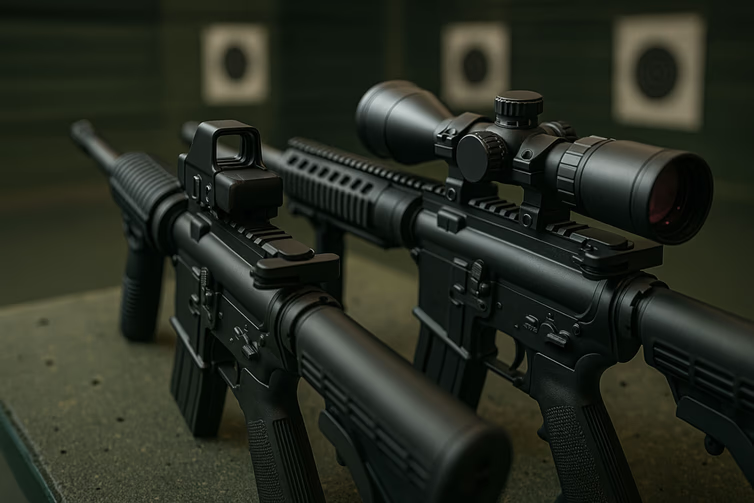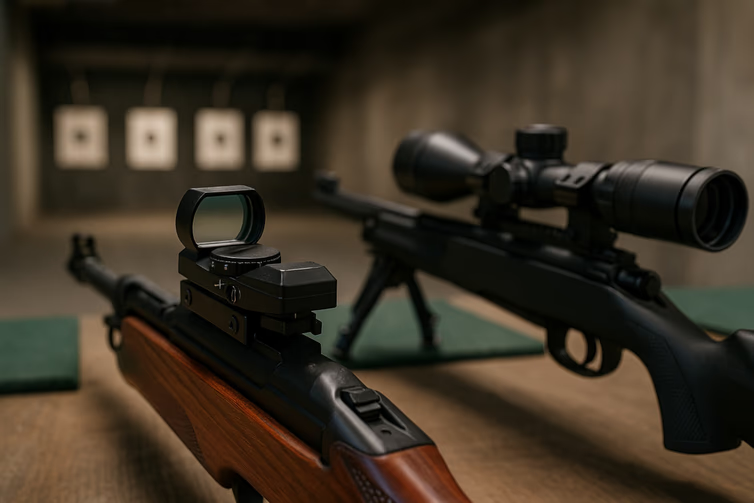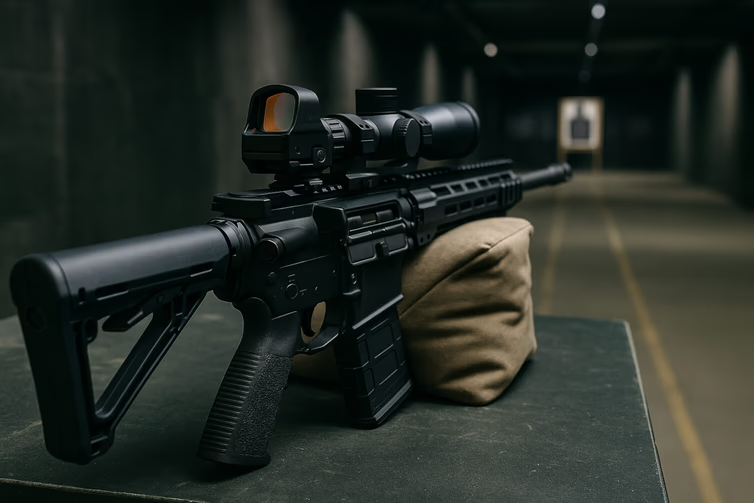How to choose a sight: collimator or optical?

Choosing a sight is an important issue, the solution to which directly depends on how accurate and comfortable shooting will be. Optical and collimator sights have a number of advantages and features. Therefore, the choice between them is made based on several factors, such as, for example, the purpose of use and the shooting distance.
In this article, we will figure out what is better - a collimator or optics, we will consider their types, pros and cons, depending on the area of application.
The main differences between a collimator sight and an optical sight
Both collimator and optical sights are used to improve shooting accuracy, but they have functional differences.
Optics is a system of lenses that magnify the target image. Such a sight is ideal for shooting at long distances, as it allows you to see the object and its surrounding details better.
A collimator is a sight in which a light point is formed and projected onto a lens. It allows you to quickly aim, since the shooter does not need to align the sight with the front sight. However, such a sight does not have target magnification, which means it is convenient to work with only at medium and close ranges.
What is a collimator sight used for: a brief description
A collimator sight does not have a reticle, although its overall design resembles an optical sight. Instead, its design includes a sighting mark (a luminous dot), a dot in a circle, or a circle without a dot, formed by a light source. It has a wide field of view and does not have a “parallax effect”. Such devices are often used on gas-cylinder weapons.
The market offers open and closed collimator sights. Open ones have lenses and a light source in the design, have a wide field of view and, at the same time, are sensitive to moisture, dirt, and mechanical impact. Closed collimators are equipped with an additional lens and a housing that protects the product from external adverse factors, but have a narrower field of view.
In what situations is it used
Reflex sights are used at short shooting distances, in small spaces or when there are time constraints for a shot. This is a huge advantage where every second counts. Despite the fact that such a sight does not magnify the image, it can be used to aim intuitively or with both eyes open.
Application areas of reflex sights:
- Close combat.
- Sport shooting.
- Airsoft.
- Battles within urban areas.
- Dynamic hunting (in cases where the prey is moving quickly).
Advantages
The collimator sight has a number of undeniable advantages:
- Quick aiming - 0.2-0.5 sec and shooting with open eyes.
- Large viewing angle, which is convenient for shooting at moving targets.
- Small dimensions and weight - this ensures ease of transportation.
- There is no parallax, which means the dot always holds the target.
- Reliability within the framework of tactical combat conditions.
Disadvantages
Among the disadvantages and features of the collimator:
- No magnification, can only be used at short and long distances - up to 150 meters.
- Red dots can be distracting.
- Depends on the power source: most models have a backlight with a battery that requires regular recharging.
- In inexpensive options, the glass often glares and distorts the image.

What is an optical sight used for: a brief description
Optical sights by their design are a tube with a built-in complex multi-lens system. This is one of the reasons why it is important for novice shooters to understand how to properly sight in optics on a carbine.
Optics have a magnification with variable or constant magnification. The design also provides a reticle for precise targeting, terrain survey and determining the distance to the object.
An optical sight allows you to adjust the magnification and does not require a power source.
In what situations is it used
Optical sights are applicable in various situations:
- During hunting - when shooting at long distances (for example, deer, roe deer hunting).
- Sniper shooting.
- For shooting from shelters.
- Sports, training shooting.
In general, optical sights are universal.
Advantages
The main advantages of an optical sight:
- The ability to magnify the image from 3-25 and higher.
- Long-distance shooting with high accuracy.
- Variable magnification sights have a magnification adjustment function.
- A large selection of models with different magnification and objective lens diameters.
- Precise correction of the bullet trajectory.
- Suitable for firing positions designed for a long time.
Disadvantages
Optical sights are characterized by the following features:
- High magnification reduces the field of view, and this affects the accuracy of shooting at short distances.
- It takes more time to aim, since the shooter needs to align his eyes with the sighting line.
- Overall models are quite heavy and less convenient to use, compared to collimator sights.
- Relatively high cost, if we are talking about high-quality optics.

Selection Criteria
When choosing a sight for a weapon, it is important to consider several key characteristics, including the shooting range, conditions of use, type of mount and reticle.
Shooting distance
The distance to the target is key when choosing a sight:
- A collimator sight is suitable for a distance of up to 50 meters. The device will allow you to quickly aim and get a wide view, which is extremely important for accurate shooting at moving, close targets.
- If the target is removed at a distance of about 50-200 meters, then in this case the decision is made based on the shooting style. For high-speed shooting, it is better to use a collimator. For stationary targets - optics with a magnification of 2-4x.
- Distance to the target is more than 200 meters involves the use of an optical sight. The most suitable option is optical sights with variable magnification (4–12x, 6–24x).
Weapon type and mount
Air, rifled, smoothbore and other weapons are equipped with different sights adapted to specific characteristics. In addition, when choosing a sight, the type of reticle is important. In particular, when shooting at different distances or to compensate for bullet drop.
Before buying a sight, you should make sure that the mount is suitable for the weapon, compatible with it and guarantees reliable fixation. Good fixation eliminates displacement during recoil. There are such types of mounts on sale as a bar, side mount, rings of various diameters and heights, and others. The height of the mount is responsible for the correct position of the eye in relation to the sight. In addition, the material of the mount is important: often the product is made of steel and aluminum, each of which differs in strength and weight characteristics.
Target type (moving, night, point)
A shooter must know how to aim a rifle or other type of weapon correctly. But when it comes to shooting with a scope, the type of target is also important - its mobility, lighting conditions, size.
For moving targets, choose collimator sights, for hunting in the dark - optical sights with night vision or high light intensity. Point targets at a great distance are also effectively hit by optical sights with high magnification and sharpness.
When used on moving targets located at a short or medium distance, a collimator ensures quick targeting.
Terms of use (forest, field, night, rain)
High-aperture sights improve visibility at dusk due to the large diameter of the objective lens and coated optics. During daylight hours, you can use devices with any luminosity. The use of products with illuminated aiming marks helps to aim at the target in poor lighting.
Collimators in tactical conditions, outdoors, in bad weather, for example, in the rain, allow you to adjust the brightness settings, ensuring visibility of the reticle in any lighting.
Which sight is better - a collimator or an optical one? Let's briefly summarize their main characteristics:
As can be seen from the characteristics, when choosing between optics and a collimator, you should not be guided by the principles of - good or bad. The main criterion for choosing is determined by the purpose, since there are no universal sights for all tasks.
A collimator sight is the best choice when it comes to speed and close combat conditions. An optical sight will allow you to accurately hit a target at a great distance. This means that the right choice is to ensure that the device does not interfere, but contributes to the best shooting result.
It is important for beginner shooters not only to decide on the choice, but also to understand how to use an optical sight and collimator. Contact the shooting club in Kyiv, where experienced instructors will help you get the necessary skills in the shortest possible time.
Contacts
- MN - FR
- 10:00 - 21:00
- ST - SU
- 10:00 - 22:00
- E-mail